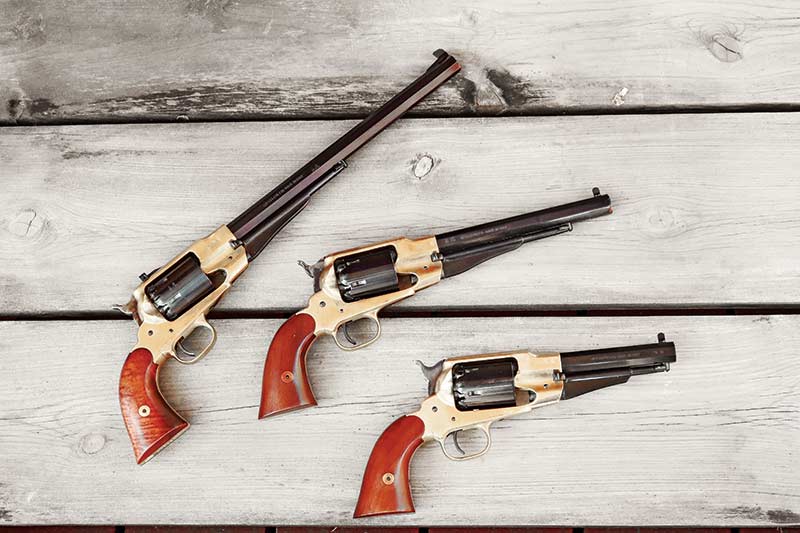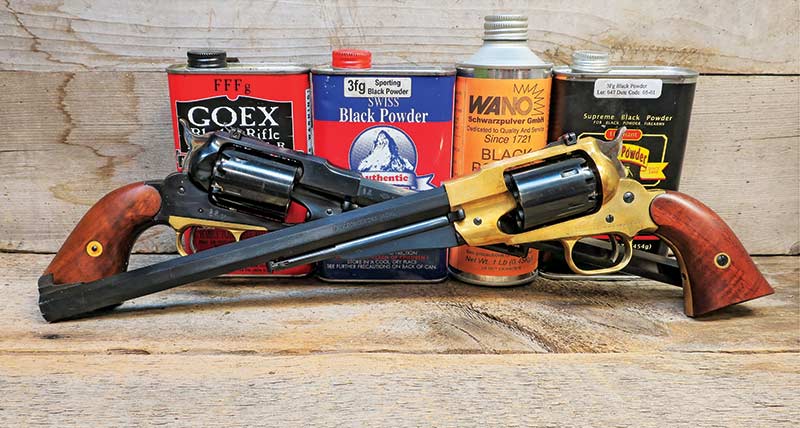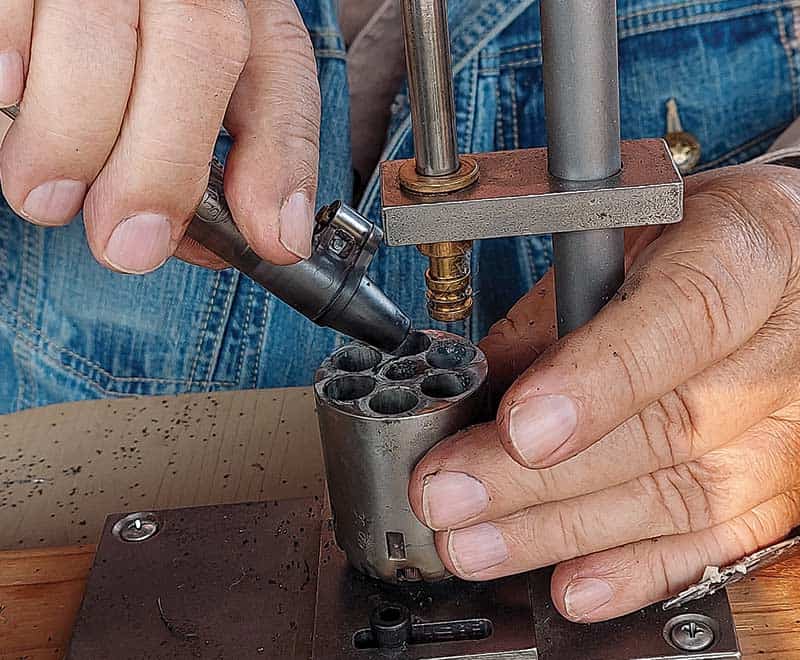Black Powder Sixguns
The Ultimate Loading Guide
Serious shooters/handloaders know how much work it is, or at least it can be, to find a really good load. There are so many choices of powders and bullets the search for the best load from one particular gun is endless. Shooting black powder sixguns is so much simpler. All one has to do is dump a little powder in the chamber, seat the ball, cap and shoot. So simple. Or is it?
Looking for the best load for percussion sixguns is not all that different from cartridge-firing sixguns in the endless possibility of choices. Doing a little math, it appears there are around 8,000 possibilities of load and bullet for only one .44 sixgun — while I have 30 .44s at my disposal for testing. So now we are up to 240,000 possibilities. Whew! Oops, we forgot the number of shots needed. For each combination I would need to fire a minimum of six shots, which brings us up to over 1.4 million rounds fired. I think I better go get started. So, what do we need to get into successful black power shooting with percussion sixguns/cap & ball revolvers?
POWDER: There are two types of propellant available, original black powder and black powder substitutes. Repeat after me and never forget: Do not use smokeless powder of any kind! I was just talking to our range manager recently and he told me of a fellow who had been out to the range earlier in the week and had his new percussion black powder revolver. He was just starting to load it when my friend noticed something very important. He did not have black powder or black powder substitute!
What he did have was smokeless powder that he called pistol powder. If my friend had not noticed, what was about to happen could have been serious. The gun would certainly have been destroyed and the shooter possibly seriously injured or worse. Yes, I do know Ruger torture tested their Old Army revolver with smokeless powder. That was a test to see the strength of their sixgun. Neither they nor I would ever advocate someone actually, as they say, trying this at home. As dangerous as this would be in a Ruger Old Army, the Italian replicas, be they on the Remington or Colt basic pattern, are nowhere near as strong as the Ruger.
I use four brands of black powder, Goex, Swiss, Wano and Elephant Brand. Black powder comes in granulations, normally FFFFg, FFFg, FFg, Fg, which are the finest to largest respectively. The best powder choice for .36 and .44 sixguns is what we call Triple-F, or FFFg. Replica powders include Pyrodex, Triple Seven and R-S and these also come in the different granulations though not necessarily all of them. Black powder or a black powder substitute is always measured by volume, not by weight. For example Pyrodex in the same amount as Goex will weigh lighter; however, both are used with a volume measure. So if 30.0 grains is the desired charge, no matter which type of powder is selected, a 30.0 volume measure is used. Triple Seven is hotter than Pyrodex and starting charges should be reduced about 20%.
PERCUSSION CAPS: These are listed by several manufacturers; however, those I have been able to find relatively easy in the past few years have been from Remington and CCI. I have #10 of the former as well as #10 and #11 of the latter. The Remington #10s I bought this past month are advertised as being hotter than the recent Remington caps, and CCI has both Standard and Magnum caps available.
The nipples, or “cones” as they are sometimes called, found on replicas today are made to a price that often means one size doesn’t fit all or anything. They will be found to be too tight for some and too loose for others. Both of these can cause ignition problems, or even the caps falling off when they are fired. I routinely equip all replica percussion sixguns with aftermarket nipples made to function properly rather than to be under a price point. My choice are SliX-Shots. They are made to fit both Remington #10 and CCI #11 as perfectly as possible. They are also made of stainless steel and have a vent hole on the side to help prevent caps from fragmenting when they are fired. If this happens, caps or portions thereof can fall into the action and lock up the revolver. This rarely happens with these custom nipples. If it does, a stronger mainspring will usually alleviate the problem.
ROUND BALLS: These are pure lead and can be cast from several brands of molds or they can be purchased swaged from Hornady or Speer in diameters of 0.451″, 0.454″, 0.457″ and 0.375″. One of the keys to good performance with .44 cap and ball sixguns is a properly fitting ball. A tight fit not only aids accuracy, it also prevents chain fires, which is more than one chamber igniting at a time. If the round ball is tight enough when it is seated, a ring of lead will be swaged off and usually wrap itself around the loading rammer. Most of my Remington and Colt pattern replicas work best with 0.454″ round balls while Ruger Old Army percussion sixguns require 0.457″.
LOADING: All cap & ball sixguns, whether they be Remington or Colt replicas, operate the same way. The powder charge is placed in the cylinder chamber, a wad is placed over the powder if desired and an oversized round ball is seated using the built-in rammer under the sixgun barrel. That’s the simple outline.
Before any percussion pistol is loaded and especially after it has been stored in an oiled condition, the nipple holes must be inspected to make sure they are clear. I always run a nipple pick in each hole. If the sixgun has been stored with oil in the cylinder chambers, percussion caps should be placed on each nipple and fired to clear the charge holes. Again, this is before loading. If this is not done, there is a good chance the loading will push oil into the nipple charge hole and the gun will not fire. To be sure, it doesn’t cost much to do this operation twice; then it is pretty well certain the charge holes are cleared.
LUBE: The proper lubricant also helps to reduce the possibility of chain fires, but the main use is to keep powder fouling soft and to a minimum. There are two schools of thought on the use of lube. One is the use of a felt wad in between the powder charge and the ball while the other is a relatively soft lube, which is applied to the loaded ball filling out the chamber. I am an equal opportunity employer — that means I use both. In the past I have used Crisco in each chamber; however, now I make my own usually mixing equal amounts of beeswax and mutton tallow, or beeswax and vegetable oil. The former is used mostly in warmer weather while the softer latter recipe is saved for cooler temperatures.
TOOLS: Just as with loading smokeless powders in modern revolvers, there are a number of tools available to help make our task easier. An adjustable powder measure definitely helps as well as a brass flask to hold the powder. There are a number of tools for holding caps including straight-line versions holding about 20 caps and a “snail” model with a capacity of about 100 percussion caps. If I don’t have more than enough to cap one cylinder at a time, I prefer the latest Polish/Swedish Capper, a round plastic piece with six arms each holding one cap. These are extremely easy to load and then place the cap on the nipple.
A loading stand provides the third hand needed when loading the cylinder; however, I prefer to remove the cylinder and use a separate reloader. All Remington pistols have easy-to-remove cylinders and some Colts also. Especially when fitting tight round balls, the added leverage is quite welcome to the hand. SliXprings also offers a SliX Hand which fits over the handle of the loading lever on revolvers and this also provides extra leverage and treats the hand gently. A quality nipple wrench that really fits the nipples is also required and again I look to SliXprings for their SliX Wrench.
MODIFICATIONS: We’ve already mentioned one very important modification, the addition of quality stainless-steel nipples. The face of the hammers should also be inspected and any sharp edges or burrs removed as these can grab fired caps and pull them off the nipple, dropping them into the action. Inspecting the Colt hammers is especially important as they have a notch in the bottom face fitting over a pin found between each chamber to serve as a safety. These are often sharp and require smoothing with a stone and/or file.
The Remington replicas have a mainspring strain screw as found on current Smith & Wesson double-action revolvers. I have found it necessary in a few examples to place a shim between the end of the screw and the spring to get a stronger hammer fall. This was accomplished using flattened empty .22 Long Rifle cases. One example required one such shim, while another needed two of them. In both cases it was enough to prevent misfires and provide 100% reliability.
We haven’t talked about powder charges at all. That will come later. For now, suffice it to say my measured powder chargers for the .44 sixguns normally range from 25 to 35 grains, while those used for the .36 are about 10 grains lighter, running from 15 to 25 grains. Experimenting will tell which loads with which powders are best — more next month.

















